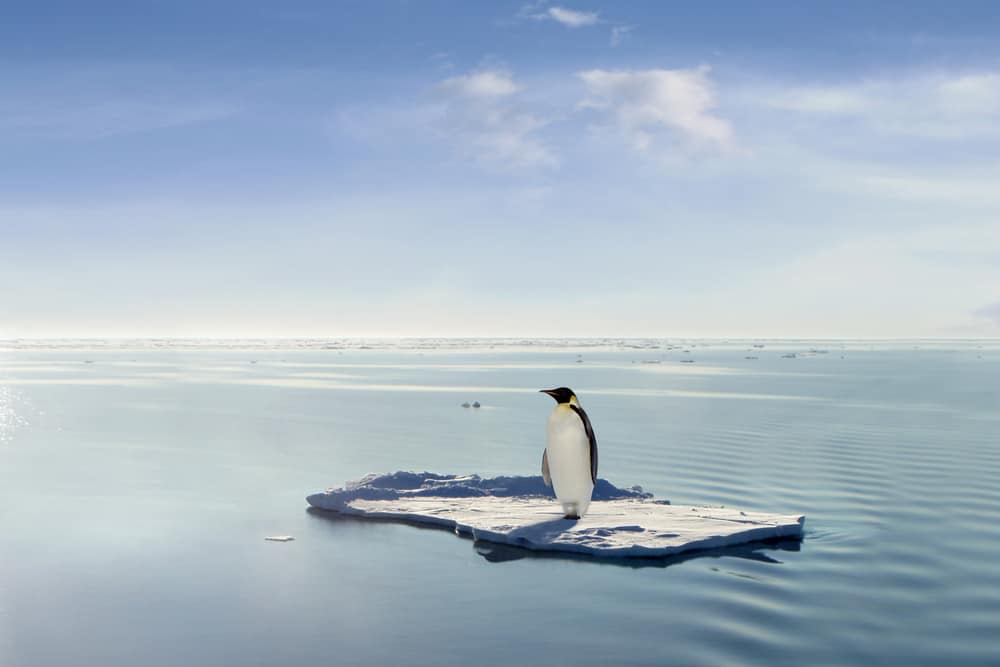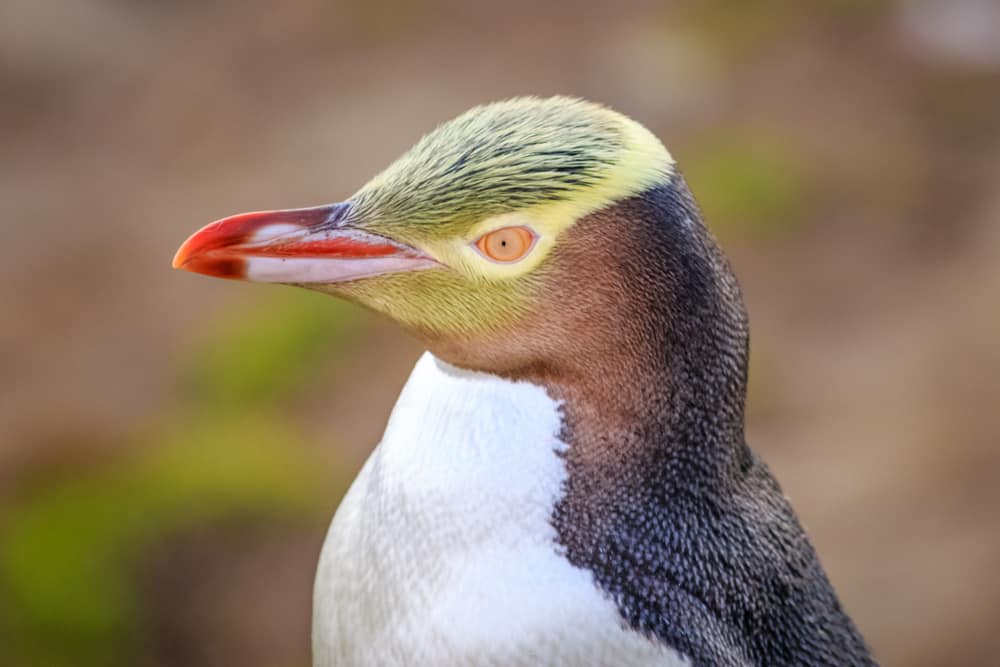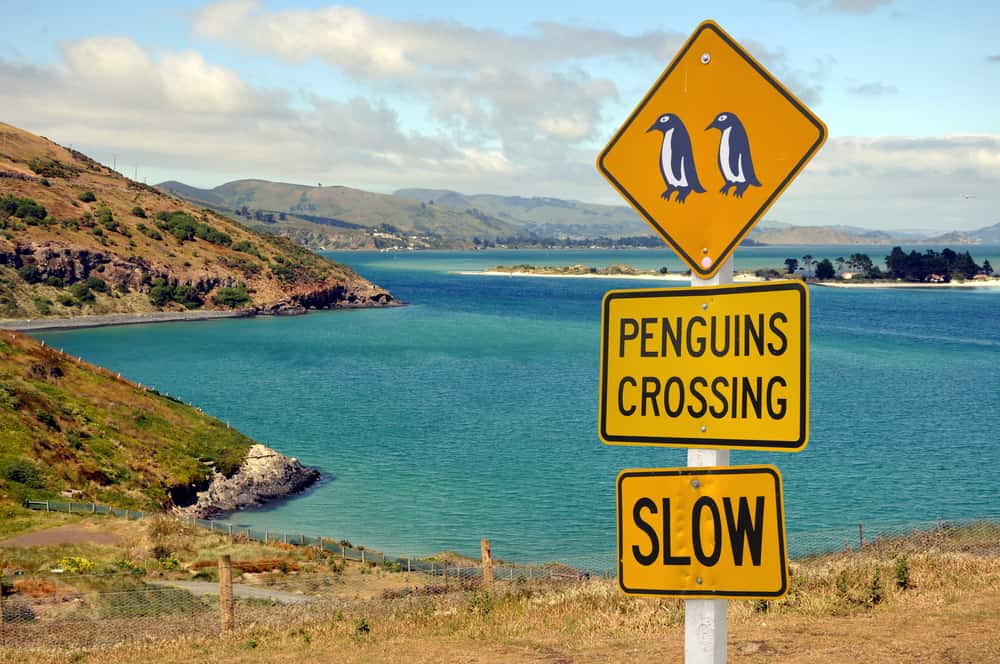Ask any resident of Alaska where the penguins are not there. It is a misconception by many people, but they are not native to Alaska and all countries in the Southern Hemisphere home. Penguins are nature’s adorable flightless aquatic birds, and cannot handle the various climate conditions in the Northern Hemisphere. The Southern Hemisphere sports 20+ species. They naturally range from the Galapagos Islands on the equator and continue through the rest of the Southern Hemisphere.

A penguin on a floe drifting through Antarctica. Unfortunately, the sea ice is not always so solid.
©Jan Martin Will/Shutterstock.com
Direct Effect of Climate Changes
Climate change has the biggest effect on penguin colonies all over the world. These specific changes include changing wind patterns, and rising temperatures which secondarily result in sea-ice loss. If there is no stable fast ice formation it easily breaks apart and could mean catastrophe for various species of penguins. Food sources are also continually in jeopardy. These unique aquatic birds as well as other marine life depend on having food constantly available. All variety of species eat a variety of seafood such as fish, squid, and crustaceans. Smaller species like to eat krill. The number of krill available has greatly decreased by 80%. All of this bird hunting is done underwater.
Areas Penguins Live in the Southern Hemisphere
Penguins aren’t roaming in Alaska, but they call home to a variety of countries in the southern hemisphere. Many people think of Antarctica first when looking for their geographic location, and expect to see the regular black and white coloring (called countershading). These amazing water-loving birds come in a wide variety of coloring based on the environment they live in so they can evade predators. They are natural divers as well and even have adapted different-sized flippers. Species even have a bare area along their faces to control overheating in areas of higher temperatures. These feathery aquatic birds call a number of the sub-Arctic islands a home. South Georgia Island is a British Overseas Territory, and home to the main penguin species which include:
- King penguin – One of the deepest divers.
- Macaroni penguin – Sport lush orange plume feathers and is the largest of the crested beauties.
- Gentoo penguin – One of the fastest species and can swim at speeds of up to 36km/h.
- Chinstrap penguins – Eat snow to cool down when feeling too warm and have distinct chin markings.

A closeup portrait of an endangered yellow-eyed penguin looking to the left.
©Michael Smith ITWP/Shutterstock.com
Other Southern Hemisphere countries where we know penguins live include:
- South Africa – Sole home to the African penguin and sentinal of ocean health.
- Chile – Visit Madalena Island. While there see the Magellanic penguins, whose distinctive colors protect them from predators.
- Peru – Humboldt penguins are noticed dotting the coastal shorelines, but be wary of their nests as made up of layers of guano.
- Galapagos Islands – Galapagos penguins are endemic to the Galapagos Islands and they are the second smallest species in the world.
- New Zealand and Australia – Both are home to Little Penguins, which are the smallest species in the world.
Where do penguins originate from?
Researchers suggest that original penguins began to develop in New Zealand and Australia 22 million years ago. Rather than the traditional sense of flying, they are a bird that evolved for swimming. The modern-day Emperor penguin is large, running between 3.6-4.3 feet in height. Not as large as its ancestor by a long shot. The discovery of Kumimanu biceae remains in New Zealand tells a tale of an extinct genus of giant penguin that lived 60-56 million years ago. After looking at the bones it to have been as tall as an adult human. These giants were prevalent in the seas and on the beaches of New Zealand over 50 million years ago. According to fossil records, there were at least 25 species.

Caution road sign penguins crossing at Otago Peninsula, New Zealand.
©Delpixel/Shutterstock.com
We Consider Certain Species on the Endangerment Scale
Penguins on the whole aren’t considered endangered unless climate changes don’t improve drastically. Daily effects overall in the colonies include habitat loss, pollution, disease, and reduced food availability due to commercial fishing. Before considered extinct the endangerment scale ranges from “least concern taken” to “threatened” to “endangered”. The King penguin is an example of the “least concerned taken” portion of the scale. It has a large population and is steadily increasing.
Meanwhile, the Emperor penguin is on the opposite end of the spectrum listing as “threatened”, due to the effects of global warming and sea-ice loss. Stable sea ice is especially important to their survival. They are ‘catastrophic moulters’, and replace their plumage once a year. During the few-week period, they cannot go into the sea and need stable sea ice to survive. They also build their nests on the ice and need strong sea-ice formations for breeding and raising their chicks. Rising temperatures and changing wind patterns lead to late sea-ice formation and early breakup.
Help and Educate Penguin Conservation Efforts
Actively help and educate others about the eminent plight of these flightless feathered friends. An interesting fact to know is that their feathers are streamlined in the water and trap more air to provide better insulation. Source out local sea bird-focused organizations (i.e. Global Penguin Society and South African Foundation For The Conservation of Coastal Birds). Penguins do not roam Alaska, but they do roam the Southern Hemisphere. The unique individual qualities of the numerous species are vast and have their highlights. Nature is diverse and birds are amazing at how they overcome environmental challenges. It is time to make the aquatic birds’ daily survival easier!
The photo featured at the top of this post is © Goinyk Production/Shutterstock.com
Thank you for reading! Have some feedback for us? Contact the AZ Animals editorial team.






